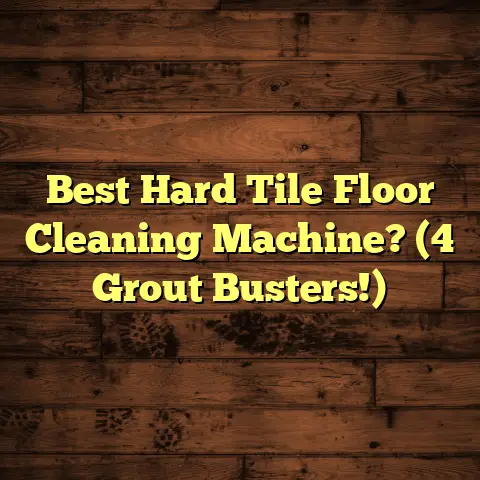Stop Concrete Moisture Damage (6 Steps Now!)
As a flooring contractor with years of experience, I’ve seen firsthand the havoc moisture can wreak on concrete. From unsightly stains to serious structural issues, it’s a problem that needs addressing ASAP.
Think about it: your basement, garage, patio, or even your driveway – all prime targets. According to the American Society of Civil Engineers, the annual cost of infrastructure repairs due to deterioration (a big part of which is moisture-related) is in the billions. Billions! And a good chunk of that is homeowners like you and me dealing with the aftermath of neglected moisture problems.
You might see efflorescence (that white powder), spalling (flaking or crumbling), or just plain old discoloration. These aren’t just cosmetic issues; they’re warning signs. Ignoring them is like ignoring a check engine light – it’ll only get worse (and more expensive) down the road.
So, what’s the good news? You can stop concrete moisture damage dead in its tracks. I’m going to walk you through six crucial steps that will protect your concrete surfaces and keep your property in tip-top shape. Let’s dive in!
Section 1: Understanding Concrete Moisture Damage
Okay, before we get our hands dirty, let’s understand what we’re up against. What exactly is concrete moisture damage? Simply put, it’s the deterioration of concrete caused by water penetrating and reacting within the material.
The Root Causes
The usual suspects are environmental factors. Rainfall is a big one, especially if it’s pooling around your foundation. High humidity can also contribute, as concrete can absorb moisture from the air. And let’s not forget ground moisture, which can wick up through the concrete through capillary action.
The Science of Porosity
Here’s a little science lesson: concrete is naturally porous. It’s full of tiny holes and channels. Think of it like a sponge. This porosity allows water to permeate the concrete. The permeability, or how easily water flows through the material, determines how quickly moisture damage can occur.
When water seeps into concrete, it can dissolve salts and minerals within the material. As the water evaporates, these dissolved substances are left behind on the surface, causing efflorescence. This might look like a minor issue, but it’s a sign that water is actively moving through the concrete, potentially causing internal damage.
Types of Moisture Damage
There are a few different ways moisture can attack your concrete:
- Rising Damp: This is when ground moisture is drawn upwards through the concrete via capillary action. It’s common in basements and can lead to mold growth and structural weakening.
- Surface Moisture: This is moisture that sits on the surface of the concrete, often due to poor drainage or leaks. It can cause staining, mildew, and freeze-thaw damage.
- Vapor Transmission: This is when moisture vapor passes through the concrete from the ground or surrounding air. It can lead to condensation, which can then cause mold and other moisture-related problems.
The Long-Term Repercussions
Ignoring moisture damage isn’t just about aesthetics. It can lead to some serious problems:
- Costly Repairs: The longer you wait, the more extensive (and expensive) the repairs will be. Cracks can widen, concrete can crumble, and you might even need to replace entire sections.
- Health Hazards: Mold growth is a common consequence of moisture damage. Mold can trigger allergies, asthma, and other respiratory problems.
- Safety Concerns: Severely damaged concrete can become a safety hazard. Cracked patios can cause trips and falls, and weakened foundations can compromise the structural integrity of your home.
I’ve seen cases where homeowners put off repairs for too long, only to face massive bills and extensive renovations. Don’t let that happen to you! Understanding the problem is the first step to solving it.
Section 2: Step 1 – Proper Site Drainage
Alright, now that we know what we’re dealing with, let’s get practical. Step one in the battle against concrete moisture damage is proper site drainage. This is all about making sure water flows away from your concrete surfaces, not towards them.
Why Drainage Matters
Think of your concrete like a fortress. A good drainage system is like a moat, keeping the enemy (water) at bay. When water accumulates around your foundation, patio, or driveway, it has ample opportunity to seep into the concrete and cause damage.
Drainage Solutions
There are several drainage solutions you can consider:
- French Drains: These are trenches filled with gravel and a perforated pipe that collects and redirects water away from your foundation. I’ve installed countless French drains over the years, and they’re incredibly effective.
- Swales: These are shallow, gently sloping channels that direct surface water away from your property. They’re a great natural solution and can even add to the aesthetics of your landscape.
- Downspout Extensions: These extend your gutter downspouts further away from your foundation, preventing water from pooling near the base of your house. It’s a simple solution that can make a big difference.
Assessing Your Existing Drainage
Take a walk around your property after a heavy rain. Do you see any areas where water is pooling? Are your downspouts effectively redirecting water away from your foundation? Are your gutters clean and free of debris?
If you notice any issues, it’s time to take action. You might need to clean out your gutters, extend your downspouts, or install a more comprehensive drainage system like a French drain.
Grading for Optimal Water Flow
Grading refers to the slope of the ground around your property. Ideally, the ground should slope away from your foundation, allowing water to naturally flow away. If the ground slopes towards your foundation, water will collect and seep into your concrete.
You can regrade your landscape by adding soil to create a gentle slope away from your house. This is a relatively simple project that can have a huge impact on preventing moisture damage.
Pro Tip: When grading, make sure to maintain a slope of at least 6 inches over the first 10 feet away from your foundation.
Proper site drainage is the foundation of a dry, healthy concrete structure. Don’t skip this step!
Section 3: Step 2 – Waterproofing Solutions
Now that we’ve tackled drainage, let’s talk waterproofing. This is where we create a barrier to prevent moisture from penetrating the concrete in the first place.
Waterproofing Products
There are a variety of waterproofing products available, each with its own strengths and weaknesses:
- Sealants: These are liquid or semi-liquid products that are applied to the surface of the concrete to fill pores and create a water-resistant barrier. Sealants are a good option for patios, driveways, and other exposed concrete surfaces.
- Membranes: These are flexible sheets of material that are applied to the concrete to create a waterproof barrier. Membranes are often used on foundations and below-grade walls.
- Coatings: These are thicker, more durable products that are applied to the concrete to create a waterproof and protective layer. Coatings are a good option for high-traffic areas like garages and industrial floors.
Application Processes
The application process varies depending on the product you choose. Sealants are typically applied with a brush, roller, or sprayer. Membranes are usually adhered to the concrete with an adhesive. Coatings are often applied with a trowel or squeegee.
Important: Always follow the manufacturer’s instructions carefully when applying waterproofing products. Proper preparation and application are essential for achieving the best results.
Choosing the Right Product
Selecting the right product is crucial. Consider the type of concrete you’re working with, the severity of the moisture issue, and the intended use of the surface.
For example, if you’re dealing with a porous concrete patio, a penetrating sealant might be your best bet. If you’re trying to waterproof a basement wall, a membrane or coating would be more appropriate.
I had a client with a persistent moisture problem in their basement. They had tried everything, but nothing seemed to work. After assessing the situation, I recommended a combination of exterior waterproofing (a membrane on the foundation wall) and interior waterproofing (a waterproof coating on the basement floor). The results were amazing. The basement was finally dry, and the client was thrilled.
Case Studies & Testimonials
Don’t just take my word for it. There are countless success stories of homeowners who have successfully implemented waterproofing solutions. Look for testimonials and case studies online to get a better idea of what’s possible.
Waterproofing is an investment in the long-term health of your concrete. Choose the right products, follow the instructions carefully, and you’ll be well on your way to a drier, more durable concrete structure.
Section 4: Step 3 – Regular Maintenance
Okay, you’ve got your drainage sorted and your concrete waterproofed. Great! But don’t think you can just sit back and relax. Regular maintenance is essential for preventing moisture damage in the long run.
The Power of Prevention
Think of maintenance as preventative medicine for your concrete. Just like regular checkups can help you catch health problems early, regular inspections and cleaning can help you identify and address moisture issues before they become serious.
Maintenance Schedule
Here’s a simple maintenance schedule you can follow:
- Monthly: Inspect your concrete surfaces for cracks, stains, and other signs of damage.
- Quarterly: Clean your concrete surfaces with a mild detergent and water.
- Annually: Reapply sealant to your concrete surfaces as needed.
Seasonal Checks
Pay special attention to your concrete before and after heavy rain or snowmelt. These are the times when moisture damage is most likely to occur. Check for pooling water, ice buildup, and any signs of cracking or spalling.
Cleaning Tips
Cleaning your concrete surfaces is a simple but effective way to prevent moisture damage. Dirt, grime, and mildew can trap moisture and create a breeding ground for mold.
Use a mild detergent and water to clean your concrete surfaces. Avoid using harsh chemicals, as they can damage the concrete. A pressure washer can be helpful for removing stubborn stains, but be careful not to use too much pressure, as this can also damage the concrete.
I always recommend using a concrete cleaner with a neutral pH. Acidic or alkaline cleaners can etch the concrete and make it more susceptible to moisture damage.
Regular maintenance is a small price to pay for the long-term health of your concrete. Make it a habit, and you’ll be rewarded with a drier, more durable structure.
Section 5: Step 4 – Addressing Cracks and Damage
Cracks are like open invitations for moisture to enter your concrete. Even small cracks can allow water to seep in and cause significant damage over time. That’s why it’s crucial to address cracks and other forms of damage promptly and effectively.
Why Cracks Matter
When water enters a crack, it can freeze and expand, widening the crack and causing further damage. This is known as freeze-thaw damage, and it’s a major cause of concrete deterioration in cold climates.
Cracks can also provide a pathway for water to reach the reinforcing steel inside the concrete. This can lead to corrosion of the steel, which can weaken the structure and eventually cause it to fail.
Identifying Cracks
Take a close look at your concrete surfaces and identify any cracks, chips, or spalls. Pay attention to the size, location, and orientation of the cracks. Are they hairline cracks, or are they wider than a dime? Are they located near joints, or are they randomly distributed across the surface?
Repairing Cracks
There are several ways to repair cracks in concrete:
- Epoxy Injections: This is a good option for repairing structural cracks. Epoxy is injected into the crack under pressure, filling the void and bonding the concrete back together.
- Sealants: This is a good option for sealing non-structural cracks. Sealants are applied to the surface of the crack to prevent water from entering.
- Resurfacing Compounds: This is a good option for repairing larger areas of damaged concrete. Resurfacing compounds are applied to the surface of the concrete to create a new, smooth layer.
Step-by-Step Instructions
Here’s a general outline of how to repair cracks in concrete:
- Clean the crack: Remove any loose debris or dirt from the crack.
- Prepare the surface: Roughen the surface of the concrete around the crack to create a better bond for the repair material.
- Apply the repair material: Follow the manufacturer’s instructions for applying the repair material.
- Cure the repair: Allow the repair material to cure according to the manufacturer’s instructions.
When to Call a Pro
For minor cracks, you can probably handle the repairs yourself. But for larger or more complex cracks, it’s best to consult a professional. A professional contractor can assess the damage and recommend the best repair solution.
I’ve seen homeowners try to repair cracks themselves, only to make the problem worse. If you’re not comfortable with the repair process, don’t hesitate to call a pro.
Addressing cracks and damage is a critical step in preventing moisture damage. Don’t ignore those cracks! Repair them promptly and effectively, and you’ll keep your concrete structure strong and dry.
Section 6: Step 5 – Indoor Humidity Control
We’ve focused a lot on external factors, but don’t forget about the inside! Indoor humidity levels can play a significant role in moisture problems, especially in basements.
The Humidity Connection
High humidity can lead to condensation on concrete surfaces, which can then lead to mold growth and other moisture-related problems. Basements are particularly susceptible to humidity because they’re often cooler and less ventilated than other parts of the house.
Controlling Indoor Humidity
Here are some tips for controlling indoor humidity:
- Use a Dehumidifier: This is the most effective way to reduce humidity levels in your basement. Choose a dehumidifier that’s appropriately sized for your space.
- Ensure Proper Ventilation: Make sure your basement is well-ventilated. Open windows when the weather permits, and consider installing a ventilation fan.
- Fix Leaks: Repair any leaks in your plumbing or foundation. Even small leaks can contribute to high humidity levels.
- Use Vapor Barriers: Vapor barriers can help prevent moisture from entering your basement through the walls and floor.
Monitoring Humidity Levels
It’s important to monitor humidity levels year-round. You can use a simple hygrometer to measure the humidity in your basement. Aim to keep humidity levels below 50%.
Insulation and Vapor Barriers
Insulation can help regulate temperature and reduce condensation. Vapor barriers prevent moisture from passing through walls and floors. Both are crucial for managing indoor moisture, especially in basements.
I had a client who was struggling with mold growth in their basement, despite having a dehumidifier. After further investigation, I discovered that the basement walls were poorly insulated, and there was no vapor barrier. We installed insulation and a vapor barrier, and the mold problem disappeared.
Controlling indoor humidity is an essential part of preventing moisture damage. Take steps to reduce humidity levels in your basement, and you’ll create a drier, healthier living space.
Section 7: Step 6 – Long-Term Solutions and Innovations
Okay, we’ve covered the basics. But what about the future? What are some long-term solutions and innovations that can help prevent concrete moisture damage?
Hydrophobic Treatments
Hydrophobic treatments are coatings that repel water. They work by creating a water-resistant barrier on the surface of the concrete. These treatments can significantly reduce the amount of water that penetrates the concrete, helping to prevent moisture damage.
Permeable Concrete
Permeable concrete is a type of concrete that allows water to drain through it. This can help reduce runoff and prevent water from pooling on the surface of the concrete. Permeable concrete is often used in driveways, parking lots, and sidewalks.
Sustainable Materials and Practices
Using sustainable materials and practices can also help reduce moisture problems. For example, using recycled concrete can reduce the amount of energy required to produce new concrete, which can help reduce greenhouse gas emissions.
Advanced Construction Methods
New construction methods are constantly being developed to enhance moisture resistance. For example, some builders are using insulated concrete forms (ICFs) to create foundations that are more resistant to moisture and temperature fluctuations.
The Future of Concrete Technology
The future of concrete technology is bright. Researchers are constantly developing new materials and methods that can help prevent moisture damage and extend the lifespan of concrete structures.
One exciting development is self-healing concrete, which contains bacteria that can repair cracks as they form. This technology could significantly reduce the need for maintenance and repairs.
I’m always looking for new and innovative ways to protect concrete from moisture damage. The industry is constantly evolving, and it’s exciting to see the progress that’s being made.
By embracing long-term solutions and innovations, we can create concrete structures that are more durable, sustainable, and resistant to moisture damage.
Conclusion
Wow, we’ve covered a lot of ground! From understanding the science of concrete moisture damage to exploring cutting-edge innovations, you’re now armed with the knowledge you need to protect your concrete surfaces.
Let’s recap the key steps:
- Proper Site Drainage: Ensure water flows away from your concrete.
- Waterproofing Solutions: Create a barrier to prevent moisture penetration.
- Regular Maintenance: Inspect, clean, and reseal your concrete regularly.
- Addressing Cracks and Damage: Repair cracks promptly and effectively.
- Indoor Humidity Control: Manage humidity levels, especially in basements.
- Long-Term Solutions and Innovations: Embrace new technologies and sustainable practices.
Moisture damage is a common problem, but it’s not insurmountable. By taking proactive steps, you can prevent moisture from wreaking havoc on your concrete and protect your property from costly repairs and health hazards.
Don’t wait until you see signs of damage. Assess your concrete surfaces today and take immediate action based on the steps outlined in this article. Remember, prevention is always better (and cheaper) than cure.
So, what are you waiting for? Get out there and start protecting your concrete! Your home (and your wallet) will thank you for it.





